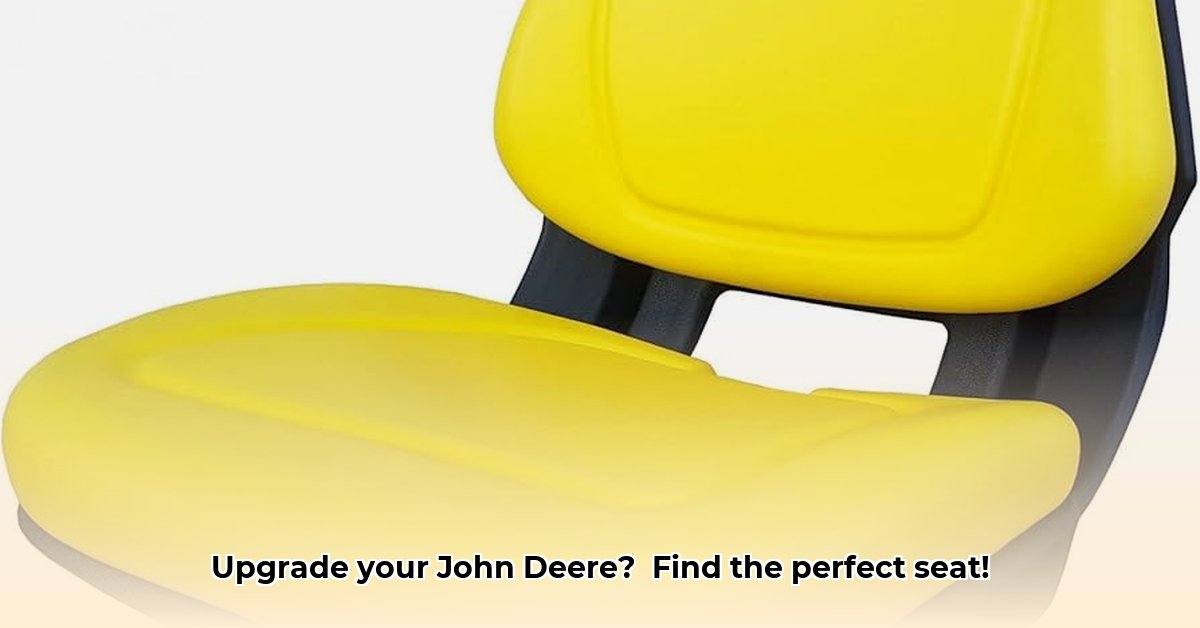
Finding the right replacement seat for your John Deere lawn tractor isn't just about comfort; it's about maximizing productivity, protecting your health, and even minimizing your environmental impact. This guide provides a comprehensive approach to selecting and installing the ideal seat. For more seat options, check out this helpful resource: Universal Tractor Seats.
Understanding Your Needs: Prioritizing Comfort, Durability, and Sustainability
Before you begin your search, identify your key priorities. Do you prioritize comfort for long mowing sessions? Is durability crucial for demanding work? Are you concerned about the environmental footprint of your purchase? Consider your usage frequency; a homeowner will have different needs than a commercial user. Addressing these questions streamlines the selection process.
Exploring Your Seat Options: OEM vs. Aftermarket
The market offers two primary options: Original Equipment Manufacturer (OEM) parts from John Deere and aftermarket alternatives.
OEM (John Deere) Seats: Guaranteed Fit and Quality
John Deere OEM seats guarantee a perfect fit, ensuring seamless installation and optimal performance. They're constructed with high-quality materials, typically offering a longer lifespan than aftermarket options. However, they come with a higher price tag. Furthermore, information on the sustainability of their manufacturing processes is often limited, but potential details may be available via their website or dealer.
Aftermarket Seats: Budget-Friendly Alternatives
Aftermarket seats provide more budget-friendly options, however, quality and fit can vary significantly. Some may need modifications for proper installation, and durability may be compromised compared to OEM counterparts. Sustainability information is often lacking for aftermarket products.
Comparing OEM and Aftermarket Seats
| Feature | OEM (John Deere) | Aftermarket |
|---|---|---|
| Fit | Guaranteed perfect fit | May require modification; fit may be imperfect |
| Quality | Superior materials and construction; longevity | Variable quality; potentially shorter lifespan |
| Warranty | Typically covered by John Deere's warranty | Warranty may be limited or nonexistent |
| Cost | Higher initial investment | Lower initial cost |
| Sustainability | Information potentially available from John Deere | Information often limited |
Choosing the Right Materials: Balancing Comfort and Longevity
The seat material significantly impacts both comfort and durability.
Vinyl: Easy to clean and water-resistant. However, it can become extremely hot in direct sunlight, compromising comfort in warmer climates.
Fabric: Offers better breathability and is more comfortable in warm weather. However, it’s less durable and susceptible to damage from the elements.
High-End Options: Gel or air suspension systems improve comfort and reduce fatigue during prolonged use but cost more.
Selecting the right material involves weighing comfort against durability and environmental concerns. For instance, is the reduced environmental impact of recycled fabric worth a slightly shorter lifespan?
Installation: A Step-by-Step Guide
Replacing your tractor seat is typically straightforward but requires care. Always consult your tractor's owner's manual for specific instructions.
Preparation: Gather the necessary tools (wrenches, screwdrivers, etc.), referencing your owner's manual.
Removal of Old Seat: Carefully detach the old seat, noting the connection points. Taking pictures during disassembly is highly recommended.
Installation of New Seat: Attach the new seat, following the reverse order of removal. Ensure all connections are secure and tight.
Testing and Adjustment: Test the seat's function, adjusting for optimal comfort and positioning.
Sustainability: An Eco-Conscious Perspective
The environmental impact of your seat extends beyond its materials. Consider the entire lifecycle:
Raw Material Sourcing: Are materials responsibly sourced? Leather production, for instance, can have significant environmental consequences.
Manufacturing Process: How energy-intensive is the manufacturing? Less energy translates to a smaller carbon footprint.
Transportation: Minimize your environmental impact by considering locally sourced seats to reduce transportation emissions.
Durability and Lifespan: A longer-lasting seat reduces the need for frequent replacements and minimizes waste.
Disposal: Consider biodegradable or easily recyclable seats to minimize landfill waste and pollution.
Isn't it crucial to consider the long-term environmental effects of our purchases? A durable, sustainably sourced seat reduces waste and lowers your environmental impact.
Maintaining Your Investment: Prolonging Seat Lifespan
Regular maintenance extends your seat's lifespan.
Cleaning: Clean regularly with suitable solutions, avoiding harsh chemicals.
Inspection: Periodically inspect for wear and tear; address minor issues promptly to prevent major problems.
Investing in a well-maintained seat ensures both comfort and longevity.
Choosing the right replacement seat improves comfort, boosts productivity, and allows you to make environmentally conscious decisions. Carefully consider your needs, explore options, and follow these guidelines for a perfect fit.